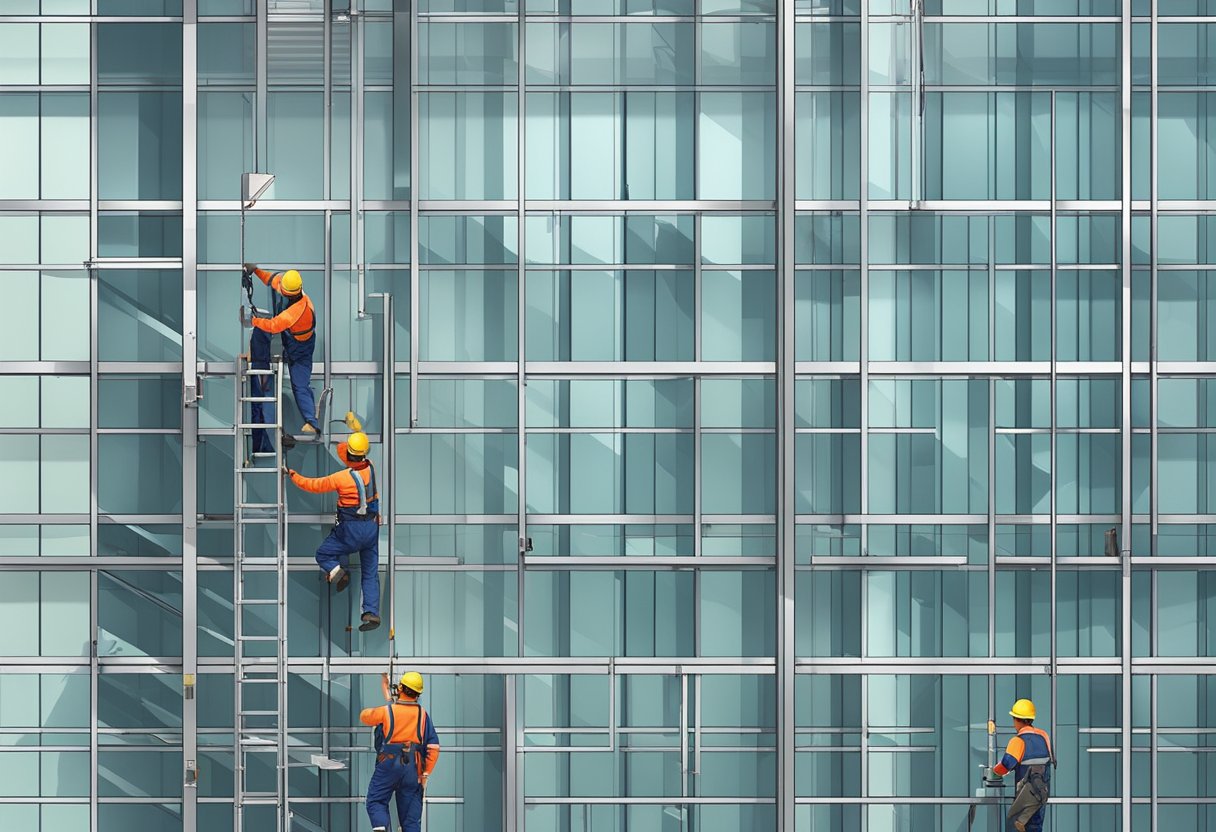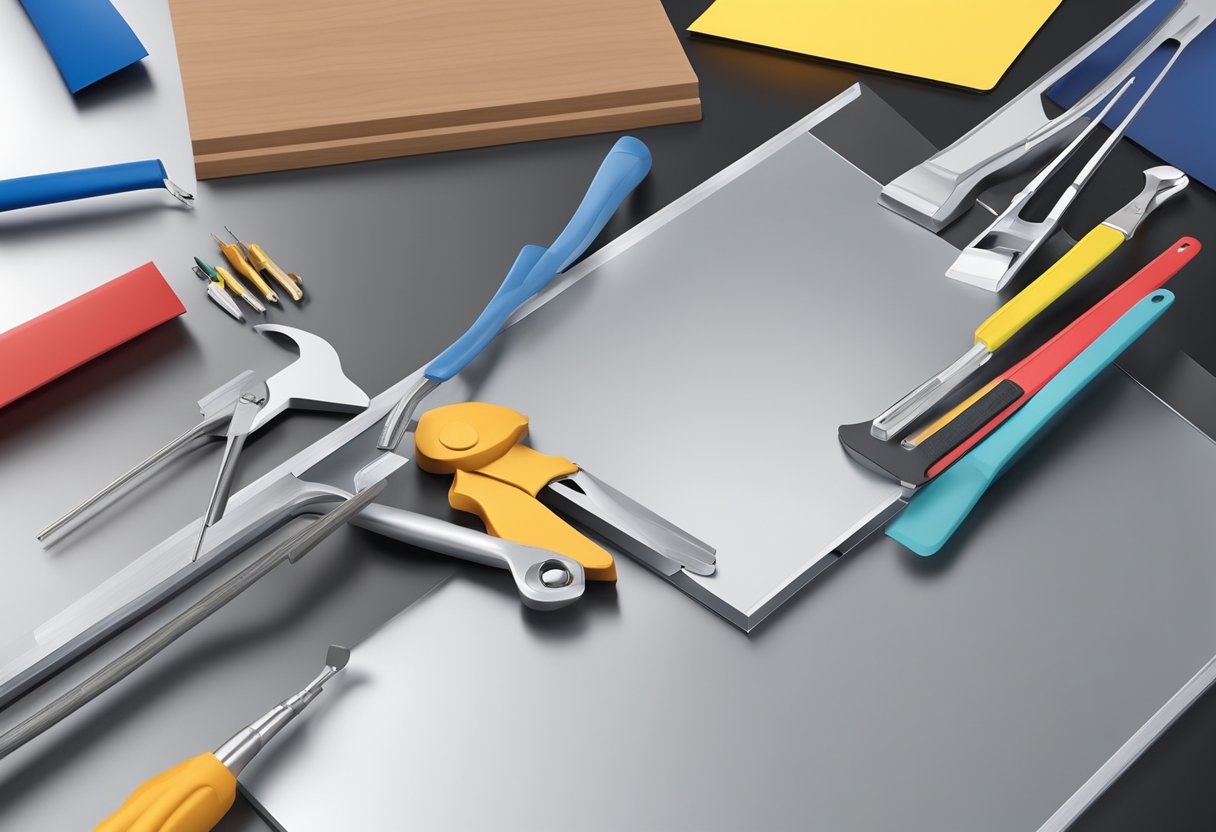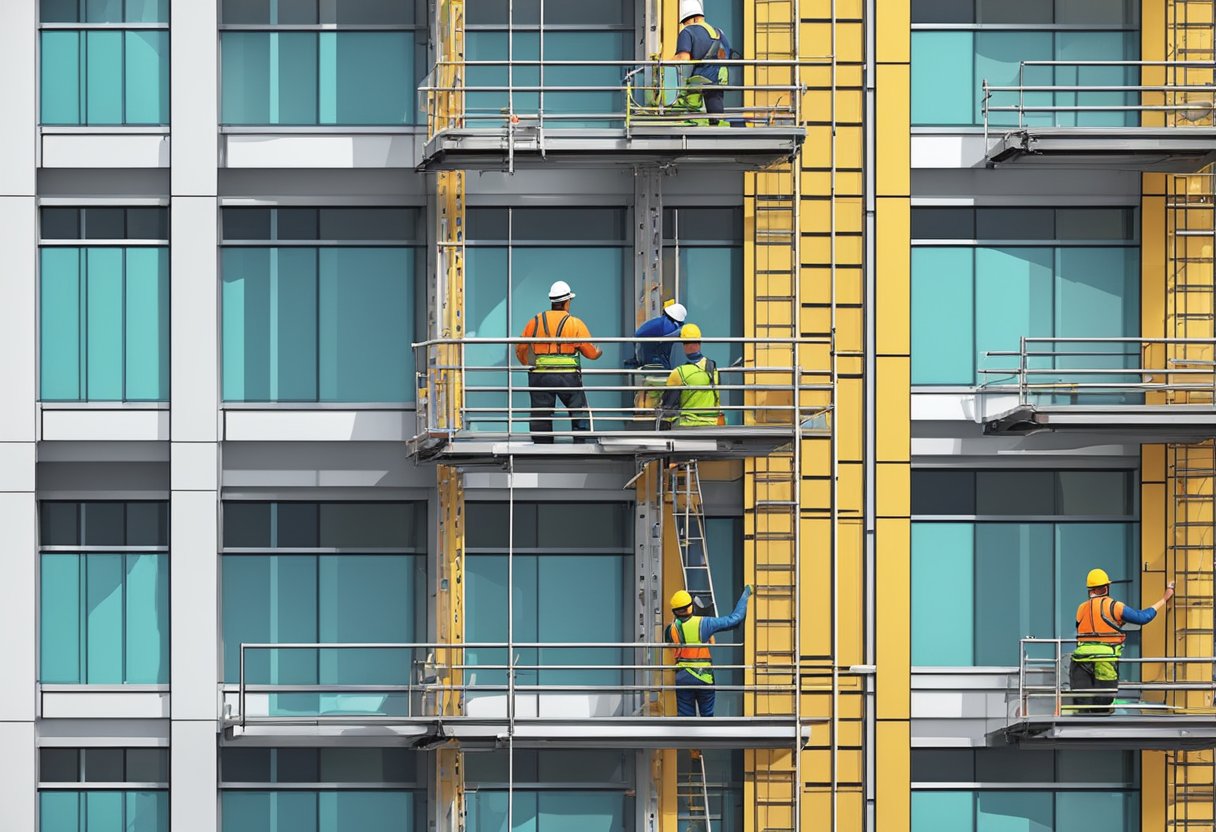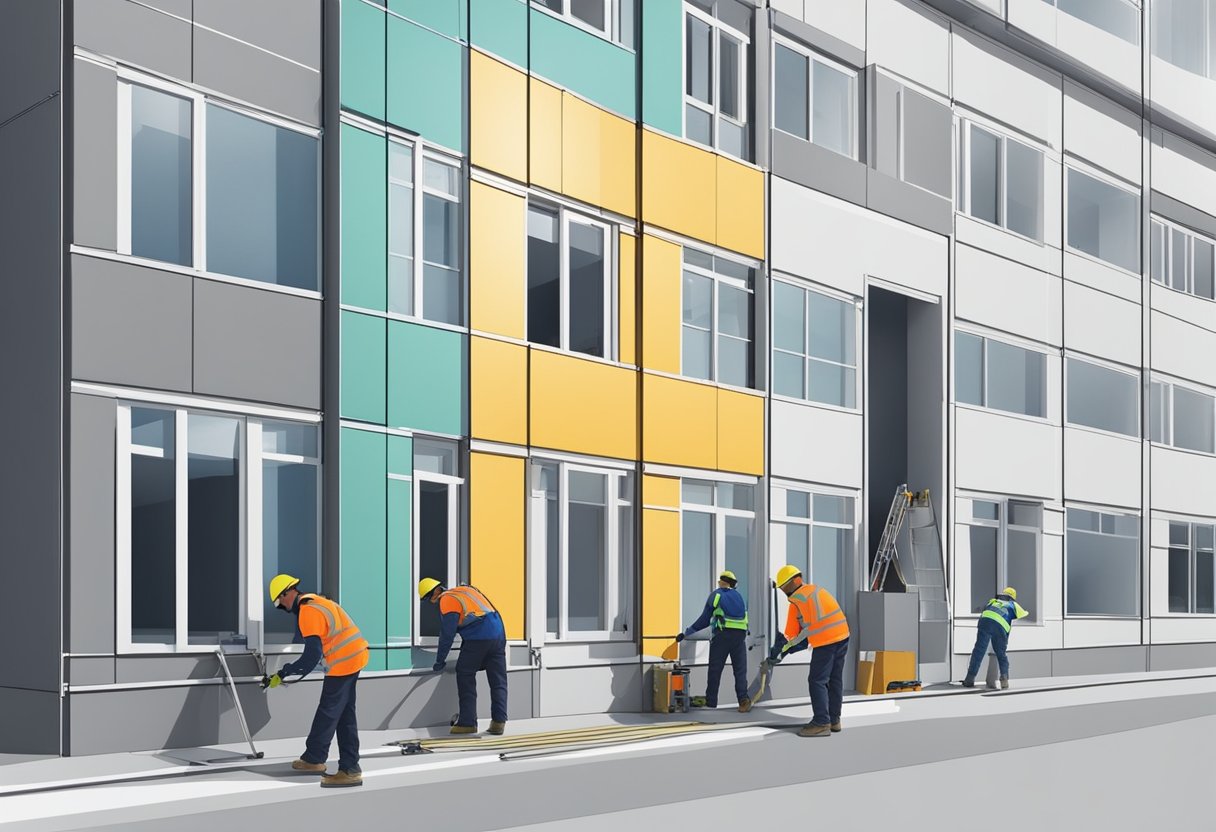Aluminum composite panel installation is a process that involves the use of lightweight, durable, and versatile panels made of aluminum and plastic. These panels are widely used in the construction industry due to their high strength-to-weight ratio, corrosion resistance, and ease of installation. They are commonly used for cladding, facades, signage, and interior design applications.

The installation process for aluminum composite panels involves several steps that must be followed carefully to ensure a successful and long-lasting installation. The first step is to prepare the surface where the panels will be installed, ensuring that it is clean, dry, and level. The panels are then cut to size and shape, and the installation brackets and fasteners are attached to the back of the panels. The panels are then installed onto the prepared surface using a variety of techniques, including mechanical fasteners, adhesive bonding, and interlocking systems. Proper installation techniques are critical to ensuring the panels remain securely attached and do not warp or buckle over time.
Materials and Tools Required

Installing aluminum panels requires specific materials and tools to ensure a successful installation. Here are some of the essential items needed:
Materials
- Aluminum composite panels
- Screws
- Adhesive
- Sealant
- Backer rod
- Joint tape
Tools
- Power drill
- Saw blade
- Measuring tape
- Level
- Hammer
- Caulking gun
- Safety equipment (gloves, goggles, etc.)
It is important to choose high-quality materials to ensure the panels are durable and long-lasting. Screws should be made of stainless steel to prevent rusting, while adhesive and sealant should be weather-resistant to withstand harsh weather conditions.
Using the right tools is also crucial for a successful installation. A power drill with a saw blade attachment can make cutting the panels to size easier and more precise. A level is necessary to ensure the panels are installed straight, while a caulking gun is needed to apply sealant.
Safety equipment should also be worn during installation to prevent injury. Gloves and goggles can protect hands and eyes from sharp edges and debris.
Overall, having the proper materials and tools is essential for a successful aluminum composite panel installation.
Safety Precautions

Personal Protective Equipment
When installing aluminum composite panels, it is important to wear the appropriate personal protective equipment (PPE) to prevent any potential injuries. The following PPE should be worn during installation:
- Safety glasses or goggles to protect the eyes from flying debris and dust
- Gloves to protect the hands from sharp edges and cuts
- Hard hat to protect the head from falling objects
- Respirator mask to prevent inhalation of dust and fumes
Handling and Storage Guidelines
In addition to wearing PPE, proper handling and storage of aluminum composite panels is crucial for safety during installation. The following guidelines should be followed:
- Panels should be stored on a flat surface to prevent warping or bending
- Panels should be stacked no higher than four feet to prevent them from falling over
- Panels should be lifted with proper lifting equipment, such as a forklift or crane, to prevent back injuries
- Panels should be handled carefully to prevent scratches or dents that can affect their appearance and performance
By following these safety precautions, installers can ensure a safe and successful installation of aluminum composite panels.
Aluminum Composite Panel Characteristics

Composition
Aluminum composite panel (ACP) is a type of sandwich panel consisting of two aluminum sheets bonded to a non-aluminum core material. The core material can be made of various materials such as polyethylene (PE), polyurethane (PU), polystyrene (PS), or mineral-filled core. The aluminum sheets are typically coated with a protective coating such as polyester or PVDF, which provides weather resistance, durability, and aesthetic appeal.
Properties
ACP has several unique properties that make it a popular choice for building facades, signage, and interior decoration. Some of the key properties of ACP include:
- Lightweight: ACP is a lightweight material, making it easy to transport, handle, and install.
- High strength: Despite its lightweight, ACP is a strong and durable material that can withstand wind, rain, and other environmental factors.
- Weather resistance: The protective coating on the aluminum sheets provides excellent weather resistance, preventing fading, chalking, and cracking.
- Fire resistance: Some types of ACP have fire-resistant properties, making them suitable for use in high-rise buildings and other fire-prone areas.
- Aesthetic appeal: ACP is available in a wide range of colors, finishes, and textures, allowing architects and designers to create unique and visually appealing facades and interiors.
Overall, ACP is a versatile and cost-effective material that offers a range of benefits for building construction and design.
Site Preparation
Before installing aluminum composite panels, site preparation is crucial to ensure a successful installation. This section covers the two main aspects of site preparation: surface assessment and substrate preparation.
Surface Assessment
The first step in site preparation is to assess the surface where the aluminum composite panels will be installed. The surface should be clean, dry, and free of any debris or contaminants that could affect the installation process. It is important to check for any irregularities or defects in the surface, such as cracks, holes, or unevenness, as these can affect the final appearance of the panels.
To assess the surface, the installer should conduct a visual inspection and perform adhesion tests to ensure that the surface is suitable for the installation of aluminum composite panels. Any defects or irregularities should be addressed before proceeding with the installation.
Substrate Preparation
Once the surface has been assessed and any defects have been addressed, the next step is to prepare the substrate for the installation of the aluminum composite panels. The type of substrate and the method of preparation will depend on the specific project requirements.
For concrete or masonry substrates, the surface should be cleaned and any loose or deteriorated material should be removed. The substrate should be allowed to dry completely before proceeding with the installation.
For metal substrates, the surface should be cleaned and any rust or corrosion should be removed. The substrate should be primed with a suitable metal primer before proceeding with the installation.
In all cases, the substrate should be free of any oil, grease, or other contaminants that could affect the adhesion of the aluminum composite panels. The installer should follow the manufacturer’s instructions for substrate preparation to ensure a successful installation.
By properly preparing the site, the installer can ensure that the aluminum composite panels are installed correctly and will provide a durable and aesthetically pleasing finish.
Panel Fabrication
Cutting
Aluminum composite panels can be cut using various tools such as a circular saw, jigsaw, or table saw. However, it is important to use the right blade or bit to ensure a clean and accurate cut. A carbide-tipped blade or a diamond blade is recommended for cutting the aluminum skin while a high-speed steel blade is suitable for cutting the core material.
Before cutting, it is important to measure and mark the panel accurately to avoid any mistakes. A straight edge or a square can be used to mark the panel. It is also important to wear protective gear such as safety glasses and gloves to avoid any injuries.
Routing and Folding
Routing is a technique used to create decorative edges or shapes on the aluminum composite panel. A router with a carbide-tipped bit can be used to create various designs on the panel. It is important to use a template to ensure accuracy and consistency.
Folding is another technique used to create bends or curves on the panel. A brake press can be used to fold the panel accurately and precisely. It is important to use the right pressure and angle to avoid any damage to the panel.
In conclusion, panel fabrication is an important step in the installation of aluminum composite panels. Cutting, routing, and folding are techniques that require precision and accuracy to ensure a high-quality finished product. It is important to use the right tools and techniques to avoid any mistakes or damage to the panel.
Installation Methods
Wet Seal Method
The wet seal method is a popular installation method for aluminum composite panels. This method involves applying a sealant between the panel and the substrate to create a watertight seal. The sealant is applied to the back of the panel, which is then pressed into place. The excess sealant is then wiped away, leaving a clean and secure installation.
Dry Seal Method
The dry seal method is another popular installation method for aluminum composite panels. This method involves using a gasket or compression seal to create a watertight seal between the panel and the substrate. The gasket or seal is placed between the panel and the substrate, and then the panel is secured in place using mechanical fasteners. This method is often used in areas with high wind loads, as it provides a secure and reliable installation.
Routing and Return Method
The routing and return method is a more complex installation method for aluminum composite panels. This method involves routing a groove into the back of the panel, and then folding the edges of the panel back to create a return. The panel is then secured in place using mechanical fasteners. This method provides a clean and seamless look, but requires more time and expertise to install.
Overall, there are several different installation methods for aluminum composite panels, each with its own advantages and disadvantages. It is important to choose the method that is best suited for your specific project, taking into account factors such as wind loads, water resistance, and aesthetics.
Panel Fixing
Mechanical Fixing
Mechanical fixing is one of the most commonly used methods for installing aluminum composite panels. It involves using screws or rivets to attach the panels to the building’s frame. The panels are typically pre-drilled to make installation easier.
To ensure a secure mechanical fixing, it is important to use the correct size and type of screw or rivet. The screw or rivet should be long enough to penetrate the panel and the frame, but not so long that it damages the panel. It is also important to ensure that the screws or rivets are evenly spaced and that they are installed at the correct distance from the panel’s edge.
Adhesive Fixing
Adhesive fixing is another popular method for installing aluminum composite panels. It involves using a high-strength adhesive to bond the panels to the building’s frame. Adhesive fixing is often preferred for its clean, seamless look.
To ensure a secure adhesive fixing, it is important to use a high-quality adhesive that is specifically designed for use with aluminum composite panels. The adhesive should be applied evenly and at the correct thickness. It is also important to ensure that the panels are properly aligned before the adhesive sets.
Overall, both mechanical and adhesive fixing methods can be effective for installing aluminum composite panels. The choice of method will depend on a variety of factors, including the building’s design, the panel’s size and weight, and the installer’s expertise.



